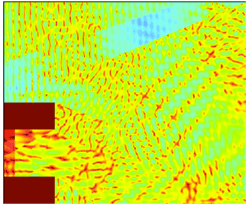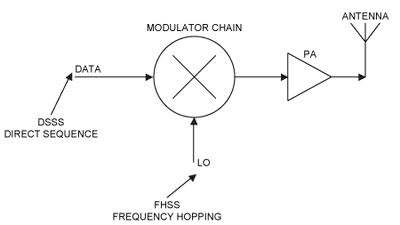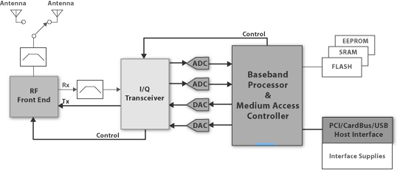Contributing Editor
Based on IEEE 802.11 standards, Wi-Fi wireless networking has become an essential feature in computers, tables, smartphones, and any device that needs to connect with others across local-area networks (LAN) or the Internet. An understanding of its data communications architecture and associated design requirements is fundamental to engineering in today's Internet-centric environment.
Wireless networks face a number of communications challenges that make them significantly different from wired networks. Wireless network topologies are fluid, lacking distinct boundaries and open to interference from external signal sources including other wireless networks. The transmitted radio waves may be reflected from objects in the path, resulting in signals reaching the receiver through multiple paths. The very transmission medium is less reliable and prone to transient changes in propagation properties. In fact, small changes in transmitter or receiver location or in the path between them can have a large impact on signal strength and data reliability. Even with a static environment like an office, signal strength can vary markedly (Fig. 1 ). The net effect of these factors is signal degradation and lost communications packets, which in turn results in lower network throughput performance.

Fig. 1: This signal strength map shows variability in radio signal strength in a room with only a desk (lower right) and door (top right). The difference between the greatest and least signal strength illustrated here is 50 dB. (Source: IEEE Std 802.11-2007.)
Wi-Fi specifications address these communications issues through vendor-independent methods for connecting electronic devices with each other and the Internet using wireless transmission at data rates similar to wired Ethernet connections. Wi-Fi operates in the unlicensed 2.4- and 5-GHz frequency bands, but certification standards managed by the Wi-Fi Alliance industry group help ensure interoperability and backward compatibility with previous generations of Wi-Fi standards even as new Wi-Fi standards continue to evolve with expanded features and performance.
Within the standard TCP/IP protocol stack, Wi-Fi standards provide services at the lowest layers of communications through 802.11 media access control (MAC) and physical (PHY) layers. The MAC layer manages communications and negotiates network access between 802.11-based stations such as network interface cards and network access points. The MAC layer performs its control functions utilizing services provided by the PHY layer, which handles the details of radio communications including carrier sensing as well as frame transmission and reception.
The PHY layer serves as the interface between the MAC and underlying wireless medium, exchanging frames with the MAC layer for transmission and reception through the wireless medium. This layer uses signal carrier and spread-spectrum modulation to reliably transfer packets over the medium. Spread-spectrum techniques essentially trade off bandwidth for reliability — literally spreading the desired signal across wide swaths of bandwidth within the allocated frequency band to reduce the impact of interference from external effects, noise, and competing RF sources. Receivers can use error-correction techniques to reconstruct data (and maintain throughput) if interference degrades a portion of the spread signal. A pseudorandom number (PRN) known to both transmitter and receiver is used as the key in this spreading and despreading operation.
Spread-spectrum methods are particularly critical for wireless networking, which can expect to face interference from competing sources. Wi-Fi signals such as 802.11b and 802.11g that operate in the 2.4-GHz ISM band are particularly vulnerable to interference since they share that frequency band with a variety of RF transmitters ranging from microwave ovens to cordless phones.
The baseline 802.11 specification defines a variety of PHY spread-spectrum techniques, including frequency-hopping spread-spectrum (FHSS) and direct-sequence spread-spectrum (DSSS). FHSS spreads the signal across the full frequency band, switching the carrier across different channels, while DSSS combines the baseband data signal with a pseudorandom sequence that spreads the signal across a greater frequency spectrum than the original signal bandwidth. In the context of the RF front end, DSSS spreads the data using the PRN key going into the mixer, while FHSS spreads the carrier frequency using the PRN going into the mixer (Fig. 2 ). Another technique, Orthogonal frequency division multiplexing (ofDM), transmits the signal across multiple frequency bands at the same time, providing even higher throughput and better protection from external RF sources.

Fig. 2: Different spread spectrum methods apply spreading techniques at different points in the basic RF front-end circuit: DSSS spreads the data stream, while FHSS spreads the carrier frequency. (Source: Maxim.)
While radio signals are transmitted using these spread spectrum techniques, digital data are encoded for transmission using one of several modulation methods. In Wi-Fi wireless networks, these modulation techniques typically include binary phase-shift keying (BPSK), quadrature phase-shift keying (QPSK), and quadrature amplitude modulation (QAM) — each tied to a particular data range or frequency band in the respective 802.11 edition.
Each evolution of 802.11 brings different PHY specifications with refined modulation techniques and radio communications methods — all designed to further improve Wi-Fi communications. The more recent evolution of the Wi-Fi standards, 802.11n further extends both PHY and MAC specifications, increasing the throughput of the MAC layer and extending the PHY layer with a more advanced form of OFDM, as well as additional data multiplexing mechanisms, including a multipath method called multiple input multiple output (MIMO).

Fig. 3: In a prototypical Wi-Fi signal chain, an RF front end (such as that shown in Fig. 2) works with an I/Q transceiver, which supplies PHY functionality, and a processor, which provides MAC functionality. (Source: Texas Instruments.)
For the electronics engineer, Wi-Fi communications requirements translate into a transceiver signal chain depicted schematically in Fig. 3 . From the antenna, an incoming RF signal passes to the switch and RF front end. The filtered intermediate frequency (IF) output from the RF front end undergoes appropriate despreading using the known PRN sequence in the I/Q transceiver or similar circuit depending on the spreading technique used. Analog-to-digital converters provide the I and Q results to the baseband processor and MAC processor for packet processing and access control functions. The process is reversed for transmission, with the PHY transceiver performing spreading using the known PRN and spread-spectrum technique available based on data rate and Wi-Fi version. ■
Advertisement
Learn more about Electronic Products Magazine





